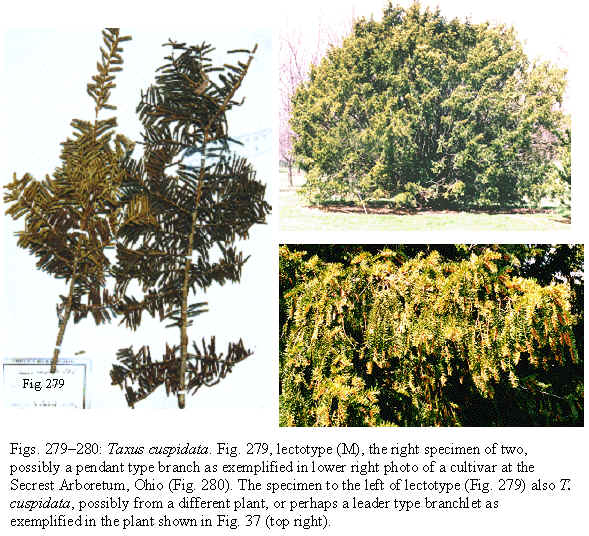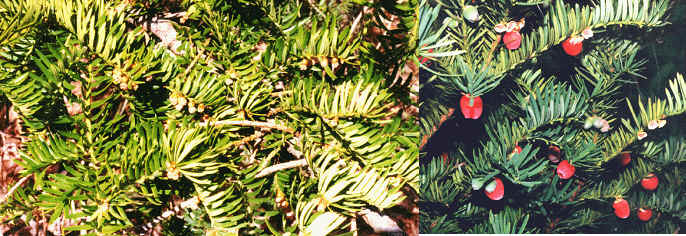|

23.
Taxus cuspidata
Siebold & Zuccarini (Fig. 147–152, 279–282), Abh. Königl.
Bayer. Akad. Wiss., Math.-Phys. München, III, 801. 1843 (in footnote:
ref. to Siebold and Zuccarini, Fl. Jap. II. tab. 128 and to [a
description] T. baccata in Thunberg(1784, Fl. Jap. 275, “foliis
solitariis, linearibus, cuspidatis, approximatis”). No specimens
cited. Taxus baccata (var.) cuspidata Carričre,
Conifčrae 733. 1867. Taxus baccata ssp. cuspidata
(Siebold & Zucc.) Pilger, Planzenreich 18 (iv, 5): 112. 1903. Type:
Japan. Lectotype (designated in Spjut, 2007b) M! (Fig. 279) with the
following data on labels “Legit in Japonia et Communicavit de
Siebold, anno 1842, ”Herbarium Regium Monacense," “Herb.
Zuccarini,” and “Herbar. Univ. Ludov. Maximil.,” the specimen on
the right of two mounted on the same sheet (Fig. 279), with mature male
cones; the left specimen also identified here as T. cuspidata is
believed to have been taken from a different plant. Isolectotypes M!,
K!, apparently from the same plant but with other data on labels.
Rigid branched yew. Distribution: Korea, Japan.
Shrub or tree; branchlets arising from a leader
branch, subpinnately arranged branchlets occasionally with shorter
recurved branchlets, appearing pendant in the type, or spreading revurved, reddish orange; bud scales persistent to the 2
nd or 3 rd yr, 3 or 4-seriate, paleaceous, brownish,
lower scales closely adnate, deltoid, indurate, ca. 1 mm long, with a
distinct narrow midnerve, the upper scales cucculate—folded inwards
over an obscure horny nerve, especially towards the apex, thus,
appearing cuspidate, 1.5–2 mm long. Leaves persistent on older twigs,
dark green, mostly in two ranks, or secund near base of branchlets, or
with an occasional upper or lower leaf spreading at right angles to
lateral leaves, especially on young shoots, linear, abruptly and
uniformly recurved near margins, convex above to a rounded or squarrose
or acute midrib that forms a channel at the base, slightly concave below
to a slightly rounded greenish or yellowish midrib; adaxial (upper)
epidermal cells wider than tall, 10–18 µm tall, 25–40 µm wide,
elliptic, thin-walled; abaxial (lower) epidermal cells epapillose in
8–20 rows from the margin, these 10–15 µm tall, 15–40 µm,
3–10× l/w, thin-walled, papillae absent or present on up to one-half
of the marginal cells, absent or present on outer midrib cells,
positioned submarginally or medially on subsidiary and accessory cells,
in 1–2 rows, concrescent; stomata bands green or yellowish-green,
broader than the marginal region, with 11–13 interrupted rows of
stomata/band. Male cone scales 5 seriate; microsporophylls ca. 8
spreading in an umbrella-like manner, united below into a flattened
ribbed column, each sporophyll with 5 cucculate microsporangia. Female
cone scales decussate-imbricate in 5 ranks; seed ellipsoidal, 4-angled
near apex, to 7 mm long, 5 mm diam, with a short nipple.
Although T. cuspidata has been
the name generally applied to any yew that occurs naturally in Japan,
Korea, E Russia, and NE China, the type seems least
representative. It does have prominent carinate bud-scales considered diagnostic by
Siebold and Zuccarini (1870), and by others (e.g., Carričre 1855;
Endlicher 1847; Pilger 1903; Rehder 1940). However, this feature is difficult to evaluate due to rather subtle variation in bud-scale
characteristics among Eurasian yews. The characters involve persistence, size (0.5–2
mm), and curvature (Cope 1998). Moreover, T. cuspidata has proved
difficult to define because of lack of taxonomic studies in the genus,
particularly in typification, interpreting relationships to cultivars,
and to other temperate Eurasian species.
The authorship of the name itself (T.
cuspidata) is even controversial because the official date of the
volume for Siebold and Zuccarini’s Flora Japonica in which T.
cuspidata appeared was not until 1870; yet, reference to this
publication, including a figure (Tab. 129 instead of Tab. 128), was first made by Zuccarini (1843) 27 years earlier at which time Zuccarini cited the name
in footnote with further reference to a description in Thunberg (1784,
Flora Japonica). Siebold and Zuccarini's (1846) synopsis of plant taxa
in Japan, which many authorities have cited as the valid publication date,
does not provide a plant description of T. cuspidata;
technically, this is a “nomen nudum” (Nakai 1938); however, reference
was made to Thunberg (1784).
Aside from Zuccarini (1843), the first direct description of T.
cuspidata appears in Endlicher (1847). Others also described the
species (e.g., Carričre 1855; Lawson et al. 1851; Parlatore 1868)
before Siebold & Zuccarini (1870), who had noted these earlier
references. However, Zuccarini's (1843) reference to a description in
Thunberg (1784) satisfies the requirement for valid publication of “Taxus
cuspidata Sieb. & Zuccar.” (Art. 32.1), indicating also the
origin of the epithet (“cuspidatis”).
Among specimens of T. cuspidata
from the Zuccarini Herbarium (syntyptes), distributed to various
herbaria, I have seen those at Harvard (GH), Kew (K), and München (M).
Not all appear from the same plant; indeed, three different
plants may be represented, two of which may be mounted on one sheet.
Data on labels and specimen sheets are also not the same; K has two
sheets, one annotated by Zuccarini in 1843, and another indicated to be
a duplicate that was apparently annotated by Maximowicz during 1860; GH
has one sheet that has the same kind of label as the lectotype, but the
year (of annotation) is somewhat illegible, appearing to be 1862, or
1842, and it also bears a branch from a female plant with handwritten
data “Fructus,” “Yeso,” “W. P. Blake,” “1862”;
M has three sheets, two of which lack reference to dates. The lectotype
was selected based on leaf and bud-scales features that best matched the
description. Additionally, the illustration in Siebold and Zuccarini
(1870, Tab. 128) does not match any of the syntypes or fide ICBN
terminology—uncited specimens (original material); rather, I consider
it to be T canadensis var. adpressa.
Taxus cuspidata is
apparently rare except perhaps in arboreta.
Figure 280 shows one of many cultivars at the Secrest Arboretum
in Ohio (Chadwick & Keen 1976) that I recognize as belonging to this
species by the leader shoots that ascend upwards, and by the long and
undivided thick branchlets that are either pendant or recurved with or
without right angled recurved branchlets. The leaves of T. cuspidata
are often distinct for their rigid erect orientation.
In addition to the type, two specimens I studied at the Arnold
Arboretum Herbarium—that were collected by Jack from Hokkaido—are
undoubtedly T. cuspidata. In
the typical specimens, the leaves are not as neatly two-ranked, the
uppermost leaves often point in the direction of the branch axis.
Taxus cuspidata can be difficult
to distinguish from T. umbraculifera. Leaves of T.
cuspidata on young shoots appear shorter (oblong) and more radial in
orientation. However, as noted above, the recurved ± pinnately
arranged branchlets distinguishes T. cuspidata. Taxus
umbraculifera has wide spreading, often ascending branchlets, except
for the divaricately branched var. microcarpa, which can be
recognized by the leaves with a ± strong two-ranked orientation near
apex of branchlets as opposed to the upwardly secund orientation in
other varieties and T. cuspidata.

The
habit of T. cuspidata, as shown above in the photos next to the
type specimen, is similar to the European Dovaston yew (T.
baccata var. dovastoniana Leighton)—known for its weeping
branches—and to other European plants in horticulture known as T.
baccata var. glauca Carričre (US: 1396503 “f. glauca
= f. subglaucescens Jacq.;” ex Hillier's Arboretum BM; ex
Herb. Petropolitani, Szovich 610, S; C. Baenitz US, “f. pendula”).
Thus, I wonder if T. cuspidata, as recognized by Siebold
and Zuccarini (1870), is of horticultural origin.
Wilson (1916) commented that he was not sure whether the yew
plants he saw in Japan were natural or cultivated, and since Siebold
& Zuccarini (1870) noted that yew there occurred in horticulture,
and in
cultivation around temples, and spontaneously in the mountains, it seems
quite possible that the original material came from horticulture.
However, at least one other specimen that was collected by Wilson from
Korea, indicates this may be a natural species.
Representative Specimens—Korea: Monastery and over the top of Hallai-san down to
Mushroom House, bush and small trees abundant as undergrowth and on
upper slopes, Wilson 9484 (A); Quelpaert Island, In-Cho 4387
(F). Japan—Hokkaido: Sapporo, 21 Aug 1905, Jack s.n.
(A). [Honshu] locality? 1862, Siebold s.n., three specimens on
one sheet, upper left is T. cuspidata, one showing underside of leaves is probably part of type
collection (original material), Herb. Zuccarinii label, p.p., with fragment on lower right
from Yeso [Hokkaido], is T. umbraculifera var. microcarpa (GH);
Insula Nippon, ubiquitous in cult. and in forest of Yezo regions, Dec
1904 Faurie s.n. (A). Cultivars—Secrest Arboretum,
Ohio: ‘Hunnewell’ forms: ‘Anglo-Japanese Yew’ A31-711;
‘Siebold’ A30-245; ‘Media Burr’ A30-16; ‘Thayer
Yew’ A30-209; ‘Hunnewell Yew’ A30-149; ‘Cuspidata
Adams’ A31-9.
|